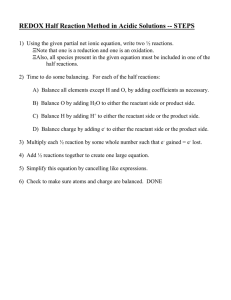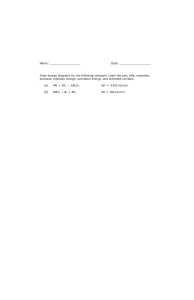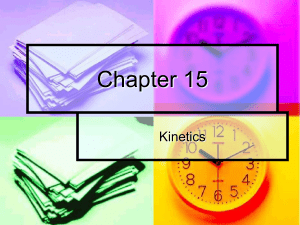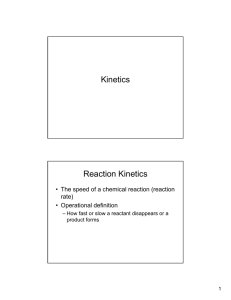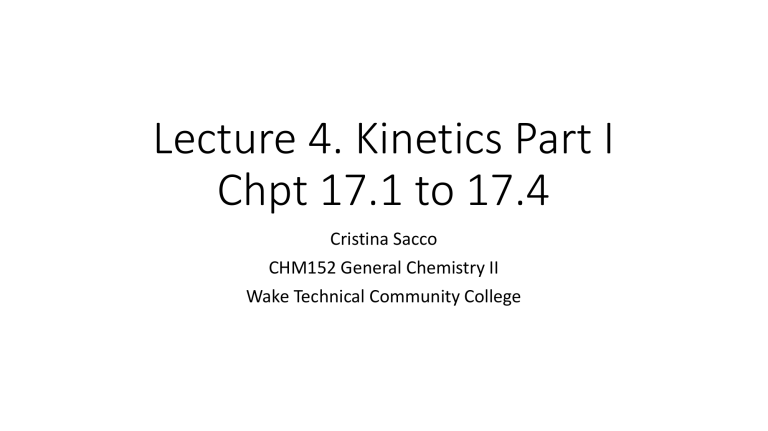
Lecture 4. Kinetics Part I Chpt 17.1 to 17.4 Cristina Sacco CHM152 General Chemistry II Wake Technical Community College I recommend viewing the slides in “presentation” mode. I try to keep the answers in a red font so you know what should be added to the guided notes. Section 17.1 Chemical Reaction Rates Are REALLY diamonds forever? Cdiamond Cgraphite No, they are not forever. This reaction is spontaneous but very slow. Formation of H2O? 2 H2(g) + O2(g) 2 H2O(l) - Non-spontaneous reaction Requires outside assistance (so rapid there is an explosion What is a reaction rate? Rxn rate = the change over time in concentration of reactant(s) - Requires outside assistance (this rxn happens so rapidly there is an explosion Units: 𝑐ℎ𝑎𝑛𝑔𝑒 𝑖𝑛 𝑐𝑜𝑛𝑐𝑒𝑛𝑡𝑟𝑎𝑡𝑖𝑜𝑛 𝑐ℎ𝑎𝑛𝑔𝑒 𝑖𝑛 𝑡𝑖𝑚𝑒 = 𝑴 𝒔 𝑜𝑟 𝑴𝒔−𝟏 𝑜𝑟 𝒎𝒐𝒍 𝒔 or mol L-1s-1 Note: [ ] means molarity! i.e. [3.2] means 3.2 M A⟶B Consider rate of A = - ∆[𝐴] ∆𝑡 Note: For any reactant (let’s use reactant A): 𝐴𝑓𝑖𝑛𝑎𝑙 − 𝐴𝑖𝑛𝑖𝑡𝑖𝑎𝑙 𝑡𝑓𝑖𝑛𝑎𝑙 − 𝑡𝑖𝑛𝑖𝑡𝑖𝑎𝑙 rate of B = ∆[𝐵] ∆𝑡 Graphical representation: = 𝑛𝑒𝑔𝑎𝑡𝑖𝑣𝑒 𝑣𝑎𝑙𝑢𝑒 But rates are always reported positive so we take the negative of that value by placing a negative sign in front of the rate of reactants. Relative Reaction Rates (related to stoichiometry) Consider A ⟶ B Q. How many moles of A are consumed for each mole of B formed? What are the relative rates of [B] and [A]? Consider C ⟶ 2D Q. How many moles of C are consumed for each mole of D formed? What are the relative rates of [D] and [C]? Consider 2E ⟶ F Q. How many moles of E are consumed for each mole of F formed? What are the relative rates of [F] and [E]? see next slide for answers Relative Reaction Rates (related to stoichiometry) Consider A ⟶ B Q. How many moles of A are consumed for each mole of B formed? 1 ∆[𝐵] What are the relative rates of [B] and [A]? rate = - ∆[𝐴] rate = A ∆𝑡 B ∆𝑡 Consider C ⟶ 2D Q. How many moles of C are consumed for each mole of D formed? 1/2 What are the relative rates of [D] and [C]? rateC = - ∆[𝐶] ∆𝑡 rateD = Consider 2E ⟶ F Q. How many moles of E are consumed for each mole of F formed? 2 ∆[𝐸] What are the relative rates of [F] and [E]? rateE = - 2∆𝑡 rateF = ∆[𝐷] 2∆𝑡 ∆[𝐹] ∆𝑡 Generally speaking, for a reaction aA ⟶ bB, rate = - ∆[𝐴] 𝑎∆𝑡 = ∆[𝐵] 𝑏∆𝑡 Only use coefficients when you do not have data and you’re just representing the relative reaction rate ex) Write the rate expression for the following rxn: CH4 (g) + 2O2 (g) ⟶ CO2 (g) + 2H2O (g) rate = see next slide for answers Generally speaking, for a reaction aA ⟶ bB, rate = - ∆[𝐴] 𝑎∆𝑡 = ∆[𝐵] 𝑏∆𝑡 ***I cannot stress this enough: Only use coefficients when you’re just representing the relative reaction rate ex) Write the rate expression for the following rxn: CH4 (g) + 2O2 (g) ⟶ CO2 (g) + 2H2O (g) rate = rate = - ∆[𝐶𝐻4 ] ∆𝑡 =− ∆[𝑂2 ] 2∆𝑡 = ∆[𝐶𝑂2 ] ∆𝑡 = ∆[𝐻2 𝑂] 2∆𝑡 ex) Write the general reaction that represents two moles of A consumed for each mole of B that is formed: Calculations: Q. Is [B] increasing • twice as fast as [A] decreases, • half as fast as [A] decreases, or • the same rate as [A] decreases? Time (s) 0 10 20 30 40 50 A (mol) 10 8 6 4 2 0 B (mol) 0 1 2 3 4 5 see next slide for answers ex) Write the general reaction that represents two moles of A consumed for each mole of B that is formed: 2A B Q. Is [B] increasing • twice as fast as [A] decreases, • half as fast as [A] decreases, or • the same rate as [A] decreases? Time (s) 0 10 20 30 40 50 A (mol) 10 8 6 4 2 0 B (mol) 0 1 2 3 4 5 Calculations: Q. If the rate of decomposition of HI is 5.0 x 10-3 mol/L·s, what is the relative rate of formation of H2 in the same reaction? 2 HI (g) ⟶ H2 (g) + I2 (g) see next slide for answers Q. If the rate of decomposition of HI is 5.0 x 10-3 mol/L·s, what is the relative rate of formation of H2 in the same reaction? 2 HI (g) ⟶ H2 (g) + I2 (g) 1) Average rate – this is the rate __________________________________ Example 1: Run A B C D E Time (h) 0.00 6.00 12.00 18.00 24.00 [H2O2] (M) 1.000 0.500 0.250 0.125 0.0625 Calculate average rate for first 6 hour period: see next slide for answers Calculate average rate for last 6 hour period: 1) Average rate – this is the rate __________________________________ Example 1: Run A B C D E Time (h) 0.00 6.00 12.00 18.00 24.00 [H2O2] (M) 1.000 0.500 0.250 0.125 0.0625 Calculate average rate for first 6 hour period: Calculate average rate for last 6 hour period: 2) Instantaneous rate – this is the rate ______________________________ Q. Find the rate at 6 hours. This graph shows the instantaneous rate of decomposition of H2O2 at any time, t, is given by the slope of straight line that is tangent to the curve at that time. Decomposition of a 1.000 M Hydrogen Peroxide Solution 1,200 Concentration (M) 1,000 0,800 Note: calculus is the easiest way to evaluate the slope of these tangent lines but it’s beyond the scope of this class. 0,600 0,400 0,200 0,000 0 6 12 18 Time (hours) Q. What is the general trend in the rates show above? see next slide for answers 24 Q. Find the rate at 6 hours. This graph shows the instantaneous rate of decomposition of H2O2 at any time, t, is given by the slope of straight line that is tangent to the curve at that time. Decomposition of a 1.000 M Hydrogen Peroxide Solution 1,200 Concentration (M) 1,000 0,800 Note: calculus is the easiest way to evaluate the slope of these tangent lines but it’s beyond the scope of this class. 0,600 0,400 0,200 0,000 0 6 12 18 24 Time (hours) Q. What is the general trend in the rates show above? - As time increases, the rate decreases (this evident by the decrease in slope of the tangent line). - Rate changes over time so the line will always be curved rather than linear Notes about the tangent line: 1) Line should touch at one point 2) Other 4 lines are only used as a guide 3) Reasonable distance from the chosen time Notes: 1) The average rates are calculated the same way you would calculate Slope of a straight line the __________________________ Time zero 2) initial rate is at _________________ Example 2: Reaction rates can be monitored using a spectrophotometer. Br2(aq) + HCOOH(aq) ⟶ (reddish) 2Br−(aq) + 2H+(aq) + CO2(g) (clear/colorless) A reaction that changes in color or color intensity over time can be followed in a spectrophotometer. time 393 nm Detector A reaction that changes in color or color intensity over time can be followed in a spectrophotometer. The absorption of light will change over time and/or wavelength The absorption of light will change over time and/or wavelength Beer’s Law: concentration and absorbance are proportional Registers the amount of visible light Average Rates Q. Use the following data, calculate the average rates for this disappearance of Br2 in the following reaction. Time (s) 0.0 50.0 100.0 150.0 200.0 250.0 300.0 350.0 400.0 [Br2] (M) 0.0120 0.0101 0.00846 0.00710 0.00596 0.00500 0.00420 0.00353 0.00296 see next slide for answers Average Rates Q. Use the following data, calculate the average rates for this disappearance of Br2 in the following reaction. Time (s) 0.0 50.0 100.0 150.0 200.0 250.0 300.0 350.0 400.0 [Br2] (M) 0.0120 0.0101 0.00846 0.00710 0.00596 0.00500 0.00420 0.00353 0.00296 Practice time! Q. The concentration of ethylene, C2H4, in the reaction 2 C2H4 (g) ⟶ C4H8 (g) was measured at 900 K and varied with time as follows: Time (s) 0 10 20 40 60 100 [C2H4] 0.884 0.621 0.479 0.328 0.250 0.169 What is the rate of change of the ethylene concentration 15 seconds after the start of the reaction? Ask yourself: are we looking for instantaneous or average rate? How do we find this rate? Step 1: Plot the data Step 2: Draw a tangent to the curve at the instantaneous point in time (see next slide) Step 3: Find the ____________________________ - I recommend creating the plot in Excel and using the lines (Go to “Insert” then “Shapes” to draw them straight to the axis. You can modify the axis to go by smaller increments so it’s easier for you to estimate the values. Since you’ll have to upload graphs for online exams this is better practice than doing it by hand. - I like adding tick marks that cross the axis. Here is a short video how to make this graph: https://www.loom.com/share/371613e025a54153aaf4649cdbc28e56 - see next slide for answers You can expand this graph to see the numbers better if you would like Section 17.2 Factors Affecting Reaction Rates Five factors affecting rates: 1. Nature of reactants 2. Surface area 3. Concentration 4. Temperature 5. Presence of a catalyst You are responsible to think about how and why these effect the rate of a reaction. https://openstax.org/books/chemistry-atoms-first2e/pages/17-2-factors-affecting-reaction-rates Activation Energy (EA): activation energy (Ea) Section 17.3 Rate Laws Rate laws are Mathematical expressions that describe the relationship between rate and concentration In general: rate = k[A]x[B]y[C]z [A], [B], and [C] = molar concentrations of reactants k = rate constant (for specific reactions and temperatures) x= y= Reaction orders z= We would say “The reaction is xth order in A, yth order in B, and zth order in C OVERALL REACTION ORDER: IMPORTANT: x+y+z The rate order is NOT related to stoichiometry but it is related to mechanism (Section 17.6) Ex) What do the following rate laws describe? a) rate = k[H2O2] -describes a reaction that is _____ order in H2O2 and _____ order overall b) rate = k [H+][OH-] -describes a reaction that is _____ order in H+ and _____ order overall Q. The rate law for the reaction: H2(g)+2NO(g) ⟶ N2O(g)+H2O(g) has been determined to be rate = k[NO]2[H2]. What are the orders with respect to each reactant, and what is the overall order of the reaction? see next slide for answer Ex) What do the following rate laws describe? a) rate = k[H2O2] -describes a reaction that is _____ order in H2O2 and _____ order overall b) rate = k [H+][OH-] -describes a reaction that is _____ order in H+ and _____ order overall Q. The rate law for the reaction: H2(g)+2NO(g) ⟶ N2O(g)+H2O(g) has been determined to be rate = k[NO]2[H2]. What are the orders with respect to each reactant, and what is the overall order of the reaction? Q. An experiment shows that the reaction of nitrogen dioxide with carbon monoxide is second order in NO2 and zero order in CO at 100 °C NO2(g)+CO(g) ⟶ NO(g)+CO2(g) What is the rate law for the reaction? - see next slide for answers Q. An experiment shows that the reaction of nitrogen dioxide with carbon monoxide is second order in NO2 and zero order in CO at 100 °C NO2(g)+CO(g) ⟶ NO(g)+CO2(g) What is the rate law for the reaction? 1 Rate = k[NO2]2[CO]0 Rate = k[NO2]2 Overall order = 2nd recall: x0 = 1 Method of Initial Rates (MIR) - this method is more helpful (involves algebra) - Requires: 1) two sets of rate data that differ in the concentration of only one reactant and 2) set up a ratio of the two rates and the two rate laws. 3) simplify ratio and solve for unknown coefficient of the concentration that varies Interpreting Results from MIR • 1st order • Reactant conc. has a proportional, direct effect on rate. • 2nd order • Reactant conc. has a squared effect on the rate. • 0th order • Reactant conc. has no effect on the rate. About rate laws: 1) Rate laws are always determined experimentally. 2) Reaction order is always defined in terms of REACTANT (not product) concentrations. 3) The order of the reactant is NOT related to the stoichiometric coefficient of the reactant. If it does happen to be the same it is just a coincidence! Q1. Determine the rate law for this reaction using the data below: Tri al 1 2 3 [F2] [ClO2] 0.10 0.10 0.20 0.010 0.040 0.010 Initial Rate (M/s) 1.2 x 10-3 4.8 x 10-3 2.4 x 10-3 F2 (g) + 2ClO2 (g) ⟶ 2 FClO (g) First, write what the rate law would be: Second, compare trials to find orders with respect to reactants: After doing this, see if you can calculate the rate constant. - see next slide for answers Q1. Determine the rate law for this reaction using the data below: Tri al 1 2 3 [F2] [ClO2] 0.10 0.10 0.20 0.010 0.040 0.010 Initial Rate (M/s) 1.2 x 10-3 4.8 x 10-3 2.4 x 10-3 F2 (g) + 2ClO2 (g) ⟶ 2 FClO (g) First, write what the rate law would be: rate = k[F2]x[ClO2]y Second, compare trials to find orders with respect to reactants: 1) compare trials 1 and 3 with respect to F2 (because [ClO2] is constant) Comparison: [F2] doubles as does the rate thus the effect is 1:1 so F2 is first order 2) Compare trials 1 and 2 with respect to ClO2 Comparison: [ClO2] quadruples as does the rate thus the effect is 1:1 So ClO2 is first order Note: overall order = 1 +1 = 2nd order thus the rate law looks like rate = k[F2][ClO2] After doing this, see if you can calculate the rate constant. Take one of the trials and plug into rate law (see next slide) Solve for rate constant (continued) Q2. Ozone in the upper atmosphere is depleted when it reacts with nitrogen oxides. The rates of the reactions of nitrogen oxides with ozone are important factors in deciding how significant these reactions are in the formation of the ozone hole over Antarctica. One such reaction is the combination of nitric oxide, NO, with ozone, O3: NO(g) + O3(g) ⟶ NO2(g) + O2(g) [O3] Trial [NO] (mol/L) (mol/L) 𝚫[𝐍𝐎𝟐] 𝚫𝐭(𝐦𝐨𝐥𝑳−𝟏 𝒔−𝟏 ) 1 1.00 × 10−6 3.00 × 10−6 6.60 × 10−5 2 1.00 × 10−6 6.00 × 10−6 1.32 × 10−4 3 1.00 × 10−6 9.00 × 10−6 1.98 × 10−4 4 2.00 × 10−6 9.00 × 10−6 3.96 × 10−4 Determine the rate law and the rate constant for the reaction at 25 °C. First, write what the rate law would be: Second, compare trials to find orders with respect to reactants: After doing this, see if you can calculate the rate constant. 5 3.00 × 10−6 9.00 × 10−6 5.94 × 10−4 - see next slide for answers Q2. Ozone in the upper atmosphere is depleted when it reacts with nitrogen oxides. The rates of the reactions of nitrogen oxides with ozone are important factors in deciding how significant these reactions are in the formation of the ozone hole over Antarctica. One such reaction is the combination of nitric oxide, NO, with ozone, O3: NO(g) + O3(g) ⟶ NO2(g) + O2(g) Determine the rate law and the rate constant for the reaction at 25 °C. First, write what the rate law would be: [O3] Trial [NO] (mol/L) (mol/L) 1 1.00 × 10−6 3.00 × 10−6 6.60 × 10−5 2 1.00 × 10−6 6.00 × 10−6 1.32 × 10−4 3 1.00 × 10−6 9.00 × 10−6 1.98 × 10−4 4 2.00 × 10−6 9.00 × 10−6 3.96 × 10−4 5 3.00 × 10−6 9.00 × 10−6 5.94 × 10−4 𝚫[𝐍𝐎𝟐] 𝚫𝐭 (𝐦𝐨𝐥𝑳−𝟏 𝒔−𝟏 ) rate = k[NO]x[O3]y 1) For x, compare trials 3 and 4 [NO] doubles, rate doubles Thus the effect is 1:1 so x=1 therefore NO is first order 2) For y, compare trials 1 and 2 [O3] doubles, rate doubles Thus the effect is 1:1 so y=1 therefore O3 is first order Note: overall order = 1 +1 = 2nd order like rate = k[NO][O3] thus the rate law looks Q3. Determine the rate law and calculate the rate constant for the following reaction from the data provided: S2O82− (aq) + 3I− (aq) ⟶ 2SO42− (aq) + I3− (aq) Run 1 2 3 [S2O82−] (M) 0.08 0.08 0.16 [I-] (M) 0.034 0.017 0.017 Initial Rate (M/s) 2.2 x 10-4 1.1 x 10-4 2.2 x 10-4 First, write what the rate law would be: Second, compare trials to find orders with respect to reactants: After doing this, see if you can calculate the rate constant. Ans: 0.08 M-1s-1[S2O82-][I-] We are going to use a more mathematical approach to MIR Consider the reaction Run 1 2 3 4 [A] 1.25 2.50 1.25 1.25 [B] 1.25 1.25 3.02 3.02 A + B + C ⟶ products [C] 1.25 1.25 1.25 3.75 Rate (M/min) 8.7 17.0 55.6 430.9 First, write what the rate law would be: Second, compare trials to find orders with respect to reactants: Can you get the orders before moving to the next slide for answers? …I don’t expect you will =) Video of me going through the answers: https://youtu.be/ddzlTXvAwDo We are going to use a more mathematical approach to MIR Consider the reaction Run 1 2 3 4 [A] 1.25 2.50 1.25 1.25 [B] 1.25 1.25 3.02 3.02 A + B + C ⟶ products [C] 1.25 1.25 1.25 3.75 Rate (M/min) 8.7 17.0 55.6 430.9 First, write what the rate law would be: Second, compare trials to find orders with respect to reactants: Summary of Rate Constants for Common Reaction Orders Reaction Order Units of k (m+n) mol1−(m+n) L(m+n)−1s−1 zero mol/L/s first s−1 second L/mol/s third mol−2 L2 s−1 Practice from OpenStax (answers in book): 13. Doubling the concentration of a reactant increases the rate of a reaction four times. With this knowledge, answer the following questions: (a) What is the order of the reaction with respect to that reactant? (b) Tripling the concentration of a different reactant increases the rate of a reaction three times. What is the order of the reaction with respect to that reactant? Answers for 13 and 21: https://openstax.org/books/chemistry-atoms-first-2e/pages/17-exercises (if a number is blue, click on it and you can get to the answers) 21. Alcohol is removed from the bloodstream by a series of metabolic reactions. The first reaction produces acetaldehyde; then other products are formed. The following data have been determined for the rate at which alcohol is removed from the blood of an average male, although individual rates can vary by 25–30%. Women metabolize alcohol a little more slowly than men: Determine the rate equation, the rate constant, and the overall order for this reaction. [C2H5OH ] (M) Rate (M/h) 4.4 x 10-2 2.0 x 10-2 3.3 x 10-2 2.0 x 10-2 2.2 x 10-2 2.0 x 10-2 Q4. (Not from OpenStax) Consider the reaction 3A + 2B ⟶ 2C + D Determine the rate equation and overall order for this reaction. Run 1 2 3 [A] 100. 200. 100. [B] 100. 300. 200. Rate (M/ms) x103 6.00 144.00 12.00 Order of A = 1, Order of B = 3 Section 17.4 Integrated Rate Laws Previously discussed rate laws were related to the reaction rate to the change in the concentration of the reactants over time ________________________________________________________ ie. A + B ⟶ C therefore rate = − ∆𝐴 ∆𝑡 = − ∆𝐵 ∆𝑡 = k[A]x[B]y We also learned: direct (linear) 1st order = reactant conc. has a ________________________ effect on rate. squared 2nd order = reactant conc. has a ________________ effect on the rate. no 0th order = reactant conc. has __________________ effect on the rate. We will now describe order like this: proportionally (linear) • If the reaction rate varies ___________________________ with the concentration of only one reactant – the reaction is 1st order _______________. exponentially (squared) • If the reaction rate varies _____________________________ with the concentration of one reactant, or is dependent on the concentration of both reactants – the reaction is 2nd order __________________. • If the reaction rate varies independently of the concentration of any 0th order reactants – the reaction is __________________. Integrated Rate Laws - another way that relates concentration of reactants and time. - used to determine the amount of reactant or product after a period of time - used to estimate the amount of time required for a reaction to proceed Ex) nuclear chemists and physicists would use integrated rate laws to determine the amount of time a radioactive material must be stored to reach safe quantities. - obtained by using calculus therefore only studying, 1st, 2nd, and 0th order reactions First Order Reactions Recall: ∆𝐴 Rate = − ∆𝑡 = k [A] math (integration) The integrated rate law can be written in one of two forms: [A]t = [A]0 e−kt or ln [A]t = −kt + ln [A]0 Where [A]0 = initial concentration of A [A]t = Concentration of A at time, t Y Graphically: = mx + b Why take ln of both sides? Because we can get a straight line which = NICE Notice that first order reactions have a negative slope Ex) The reaction 2A ⟶ B is 1st-order in A with a rate constant of 2.8×10−2 s−1 at 80 °C. How long will it take for the concentration of A to decrease from 0.88 M to 0.14 M ? - see next slide for answers Ex) The reaction 2A ⟶ B is 1st-order in A with a rate constant of 2.8×10−2 s−1 at 80 °C. How long will it take for the concentration of A to decrease from 0.88 M to 0.14 M ? Second Order Reactions A rxn is 2nd order if the overall reaction order is 2. What are these scenarios for A+BC? It can be: rate = k [A]2 or rate = k[A][B] or We will focus on the first one for simplicity reasons. Thus: The integrated rate law for a 2nd order rxn is: Y math (integration) = mx + b 1 1 = 𝑘𝑡 + [A]t [A]0 rate = [B]2 Q. The reaction of butadiene gas (C4H6) with itself produces C8H12 gas as follows: 2 C4H6(g)⟶ C8H12(g) The reaction is second order with a rate constant equal to 5.76 x 10−2 L·mol-1min-1 under certain conditions. If the initial concentration of butadiene is 0.200 M, what is the concentration remaining after 10.0 min? - see next slide for answers Q. The reaction of butadiene gas (C4H6) with itself produces C8H12 gas as follows: 2 C4H6(g)⟶ C8H12(g) The reaction is second order with a rate constant equal to 5.76 x 10−2 L·mol-1min-1 under certain conditions. If the initial concentration of butadiene is 0.200 M, what is the concentration remaining after 10.0 min? 1 1 = 𝑘𝑡 + [A]t [A]0 • Solve for [A]t NOT 1/[A]t Answer: 0.179 M Via graphing: Test these data to confirm that this dimerization of butadiene reaction (from above) is second-order. Trial Time (s) 1 2 3 4 5 0 1600 3200 4800 6200 [C4H6] (M) 1.00 × 10−2 5.04 × 10−3 3.37 × 10−3 2.53 × 10−3 2.08 × 10−3 1) Graph 1st and 2nd order to get…. (maybe copy and paste into excel to see what order before going to the next slide? You will have to know how to determine order of a reaction using Excel so you might as well practice hint hint) 1st order 2nd order Notice the y-axis 2) Check if it’s linear Since the graph is linear using the 2nd order rate law, the reaction is 2nd order Practice with Excel: Does this data follow a 2nd order rate law? Trial Time (s) 1 2 3 4 5 6 [A] (M) 5 10 15 20 25 35 0.952 0.625 0.465 0.370 0.308 0.230 Ans: yes….why? Zero order Reactions A rxn is 0th order if the rxn is completely independent of concentration of any of the reactants thus the rate law is written: rate = k[A]0[B]0 Simplified to: rate = k The integrated rate law for a 0th order reaction is math (integration) [A]t = −kt + [A]0 The Half-Life of a Reaction • The half-life, t½, is the time required for the concentration of a reactant to decrease to half of its initial concentration ________________________________________________________ • The half-life of a reaction depends on the order of the reaction __________________________. Half-life of a first order reaction: ln[A]t = -kt + ln[A]0 ln[A]0 – ln(2) = -kt + ln[A]0 4) More algebra ln[A]0 – ln(2) = -kt + ln[A]0 6) simplify t1/2 = 0.693 𝑘 Units = s-1 NOTE: You should be able to do the algebra and be prepared to do it if asked on a test. algebra t1/2 = 1 [𝐴]0 𝑘 Units = M-1s-1 algebra t1/2 = [𝐴]0 2𝑘 Units = M s-1 Examples: 1. What is the half-life of N2O5 if it decomposes with a rate constant of 5.7 × 10−4 s−1? 2.What is the half-life (in days) for the decomposition of NOCl when the concentration of NOCl is 0.15 M? The rate constant for this reaction is 8.0 × 10−8 L/mol/s. - see next slide for answers Examples: 1. What is the half-life of N2O5 if it decomposes with a rate constant of 5.7 × 10−4 s−1? The units for the rate constant are consistent with that of first order. Use the first order equation for half-life. Ans: t1/2 = 1200 s 2.What is the half-life (in days) for the decomposition of NOCl when the concentration of NOCl is 0.15 M? The rate constant for this reaction is 8.0 × 10−8 L/mol/s. The units for the rate constant are consistent with that of second order. Use the second order equation for half-life. Ans: t1/2 = 960 days Summary (shaded cells will be provided on exam) Summary of Rate Laws for Zero-, First-, and Second-Order Reactions Zero-Order rate law units of rate constant integrated rate law plot needed for linear fit of rate data relationship between slope of linear plot and rate constant half-life First-Order Second-Order rate = k rate = k[A] rate = k[A]2 M s−1 s−1 M−1 s−1 [A] = −kt + [A]0 ln[A] = −kt + ln[A]0 1 1 = 𝑘𝑡 + ( ) [𝐴] [𝐴]0 [A] vs. t ln[A] vs. t 1 vs. t [𝐴] k = −slope k = −slope k = +slope [𝐴]0 2𝑘 0.693 = 𝑘 t1/2 = t1/2 t1/2 = 1 [𝐴]0 𝑘 Practice from OpenStax (some solutions available): If available, solutions will be is OpenStax’s solution manual, but here is the link for Chpt 17 exercises: https://openstax.org/books/chemistry-atoms-first-2e/pages/17-exercises (if a number is blue, click on it and you can get to the answers) 33) Use the data provided to graphically determine the order and rate constant of the following reaction: SO2Cl2 ⟶ SO2 + Cl2 Time (s) [SO2Cl2] (M) Time (s) [SO2Cl2] (M) 0 0.100 2.50 × 104 0.0577 5.00 × 103 0.0896 3.00 × 104 0.0517 1.00 × 104 0.0802 4.00 × 104 0.0415 Hint: plot 0th, 1st, and 2nd order to see which one yields a linear line. 1.50 × 104 0.0719 36) What is the half-life for the first-order decay of phosphorus32? The rate constant for the decay is 4.85 × 10−2 day−1. 40) The reaction of compound A to give compounds C and D was found to be second-order in A. The rate constant for the reaction was determined to be 2.42 L/mol/s. If the initial concentration is 0.500 mol/L, what is the value of t1/2? 34) Pure ozone decomposes slowly to oxygen, 2O3(g)⟶3O2(g). Use the data provided in a graphical method and determine the order and rate constant of the reaction. Time (h) [O3] (M) 0 1.00e-5 2.0e3 4.98e-6 7.6e3 2.07e-6 1.00e4 1.66e-6 1.23e4 1.39e-6 1.43e4 1.22e-6 1.70e4 1.05e-6 see next 2 slides for answers 34) Pure ozone decomposes slowly to oxygen, 2O3(g)⟶3O2(g). Use the data provided in a graphical method and determine the order and rate constant of the reaction. Ozone Decomposition - 0th order 0 1.00e-5 2.0e3 4.98e-6 7.6e3 2.07e-6 1.00e4 1.66e-6 1.23e4 1.39e-6 1.43e4 1.22e-6 1.70e4 1.05e-6 1,20E-05 1,00E-05 In Excel: 0th order: 1/[O3] order: 8,00E-06 6,00E-06 4,00E-06 2,00E-06 0,00E+00 0 5000 10000 15000 20000 Time (h) Ozone Decomposition - 1st order 1st order: -11 -11,5 0 5000 10000 15000 20000 -12 -12,5 -13 -13,5 Ozone Decomposition - 2nd order 2nd [O3] [O3] (M) ln[O3] Time (h) -14 Time (h) 1,00E+06 5,00E+05 0,00E+00 0 5000 10000 Time (h) 15000 20000 If you are not sure, you can set the data to y=mx+b and show the R2 value. The closer the data is to +1 or -1, then you can call it “linear” or “more linear” 34) Pure ozone decomposes slowly to oxygen, 2O3(g)⟶3O2(g). Use the data provided in a graphical method and determine the order and rate constant of the reaction. Time (h) [O3] (M) 0 1.00e-5 2.0e3 4.98e-6 7.6e3 2.07e-6 1.00e4 1.66e-6 1.23e4 1.39e-6 1.43e4 1.22e-6 1.70e4 1.05e-6 You would technically do this calculation for every concentration you have and take an average of the k values. I just picked the 1.66e-6 for example.



